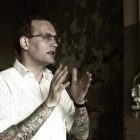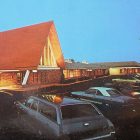A Poem for Children

The poet of Dan Chiasson’s poems is a father and a son, often both at the same time. The poet of Dan Chiasson’s poems, since his first collection The Afterlife of Objects was published in 2002, reveals more about himself, his being a father and a son, through the way his poems are made. “I have this wish to get caught up in something / Precisely unlike a poem, unlike writing / For its straightforwardness,” he discloses in the titular poem of Chiasson’s 2014 Bicentennial—and perhaps after reading this, one impulsively looks in the other direction, toward that “something unlike a poem,” for the chance to likewise experience some degree of rapture. Now we are reading words on a page, written for us, written for the poet, to be read on a page; can one state anything with clarity—how does anyone generalize, that ugly word interpret—about twenty years, a singular past, the record of a moving life? The stanza from “Bicentennial” continues to wish, earnestly, for something unlike a poem, unlike writing “for its straightforwardness, its power / That is not the power of half-secrecy / But is, instead something enormous / and potentially dangerous . . .” The poet wishes for something unlike a poem, knowing over and again, in the real time it takes to read these words, that something unlike a poem is not what we’re reading.
Bicentennial, a celebration two hundred years in process, is a book made of poems that render the scene of Burlington, Vermont in the seventies. In this place and time, in these poems, a father is not present for his son’s childhood: “Only much later did they see, the two of them / That never knowing one another, there was nothing / Not to know.” Having nothing to know is itself a knowledge: the absence of something or someone through which that knowledge can be attributed does not make it unintelligible. Later in life, the son’s childhood is over, and having since concluded, that absence can be observed as something whole. The son writes a poem. This sort of knowledge, however, is perhaps experienced first, articulated second, as in the final couplet of that poem, “Father and Son”: “If not an event, at least not a nonevent. / Which, in the end, when it happened, it wasn’t.” Following the poem’s series of negatives does not—as one might first suspect—ask readers to answer for its logic; the poem folding and unfolding its relationship to absence, back and forth, is not an intellectual project precluding what some may consider a more sincere, bare-faced approximation of this experience. What cannot or refuses to be said explicitly is articulated through a style, a way of being within the poem:
I am my father’s son
I am my father’s
Son I am
My father’s son
I am
Although the poet identifies these three sentences as an echolalia, a section of the poem “Arm in Arm,” this repetition is far from nonsensical: an experience, and the meaning one associates with that experience, is conducted through the manner in which the sentences are organized in lines. The poem ends in an emphatic reversal, as if to say, Look at how my life has changed in the time it took you to read this poem:
I am my son’s father
I am my son’s
Father I am
My son’s father
I am
The poet begins this poem as his father’s son and ends as his son’s father, and in acknowledging what has changed between these two stanzas, one reads this mirrored syntax and immediately notices what has not.
The moon positioned over Burlington, Vermont in the early seventies is the same moon staged over mid-2000s Massachusetts—here’s an example of something that has stayed the same, following its usual course. The poet’s technology for thinking about the moon has, in turn, changed; the moon, then, has changed. In Chiasson’s 2010 collection Where’s the Moon, There’s the Moon, the poet plays his version of hide-and-seek with readers and a version of I Spy with his son: “and here is the page where the man, the son / of the man who keeps the moon, has fallen asleep.” In the book’s titular poem, with its subtitle “A Story for Children,” a son reads with his father a yet-unwritten book called The Moonkeeper’s Son—about an “endless line of moonkeepers / who hang the light that lights the moon and take it down.” In this line of moonkeepers, each given the same task, there is a father, there is that father’s son, and a son’s father.
As a book contained within a book—its content described but not given—the poet inscribes himself in the figure he creates; what one learns about that figure is articulated through a style that, for some readers, misdirects from a sincerity explicitly stated within the poem (if one can call this “sincerity”). The words on this page approximate, as the poem admits, “a person age 36 years, 3 months, / name Chiasson, Dan . . .” The question of a poet’s biography appears and disappears, and everything the not-quite-fictional account of a person named Dan Chiasson means for the poem can only be accounted for as stated: “the way the moon waxes and wanes (the author intends this) / but what the author does not intend is the following point: / the moon orbits the earth . . .” All one knows from these lines is how the author intends to write “the author intends”—if we follow intention beyond “waxes and wanes,” we’ll inevitably end at our own haphazard conception of Dan Chiasson The Poet. Yet here’s what this also means: through the act of stating intention, a subjective mind with experience enough to intend watches us from behind the poem, behind the book within a book.
Because a part of Chiasson’s long project has been to make that presence palpable, vulnerable but not necessarily articulated as a vulnerability, it makes sense that Chiasson’s most recent book The Math Campers (2020) begins, “Through his eyes I see in the dark. / I see through change the static.” About a mural that appears in the real-life Chiasson household, and also about a mural that appears in the household approximated on the page, these lines from “Bloom” multiply our vision: the poet sees through the artist’s eyes, and if that is true, we see through his eyes seeing through the artist’s eyes. This is a closed circle: we’re staring at ourselves envisioning the mural. What follows is the book’s major poem, “Must We Mean What We Say?”, a four-phased work that tangibly enacts its own making in real time. Readers have been given what we’re told are drafts, dreams, conversations from Stonington, Connecticut, all of which contribute to the poem’s formulation. It’s not quite a point about how a poem is made (Chiasson’s critical prose better suits that thinking), but rather an experience to hold whenever you open this book.
Just as the mural channels our vision, just as our vision multiplies, so do the roles one plays here—like the adolescent boy, the father reading to his toddler, the old man: “like a child seen getting used to a man’s body / seen when least he wishes to be seen…” What has changed since the mid-2000s, since Chiasson’s early collections? He’s older, and the same questions from his earlier books perhaps require a slightly different process in their asking. The Math Campers is a book of changes, of adolescence, and its figures hope to realize their teenagedom will eventually end, that they, like the poet, will eventually understand their childhood did not quite follow them into the future. Throughout these years, childhoods in which one crisis immediately preceded another—”as sixth-graders learn sea-level rise / and march with their friends against guns”—how can The Math Campers make summer extend itself into autumn? The answer, in this case, is a matter of continuing to solve their equations correctly: “For every correct answer, one more hour; / a furlough from the changing leaves.”
For how often the word “secret” appears in Chiasson’s poetry throughout his five collections, one would be mistaken to think something has been purposefully hidden. The temperament of Chiasson’s poetry is never made to conceal a design operating beneath the poem, and within that embodied nerve, one finds a felt sincerity articulated through a poem’s arrangement (again, if one can refer to this quality as “sincerity”). Likewise, as Louse Glück wrote about Chiasson’s poetry in American Originality: Essays on Poetry (2017): “Chiasson is uniquely a poet for whom hiddenness is a profound psychic truth, a poet for whom guardedness corresponds to rather than precludes inwardness. The authentic self is performed as a false self, but every pose is a clue.” Because this is true, because every pose is a clue, readers have been included in this experience of discovery that Chiasson orchestrates throughout his books:
if the reader will please wait to have begun
this poem until 11:54 p.m., it will sync
up perfectly with midnight—wait, wait—
the word Forlorn on the stroke of midnight



